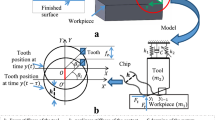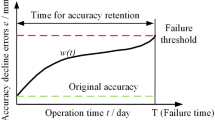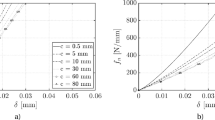Abstract
In high-speed milling, the machining system is affected by a chatter resulting from the dynamic interaction between the tool and the part, which can cause harmful effects on the tool and the machined surface of the part. Chatter occurs more frequently for the milling of thin-walled parts due to their low stiffness. In addition, the dynamic characteristics of thin-walled parts vary along the tool path. The dynamics of the part are therefore the dominant factor that should be considered in the modeling and the study of the milling process and must be performed in 3D, where the third dimension is the tool position. This paper studies the milling stability of Al 7075-T6 thin-walled parts during high-speed milling considering the variation of dynamic characteristics and develops three-dimensional stability lobe diagrams of the spindle speed, axial depth of cut, and tool position. The dynamic equations of motion are solved numerically using semi-discretization method. Modal parameters of the tool and the part were extracted experimentally by modal tests. Then, cutting tests were conducted to validate the established model by measuring the machined surface roughness which is used as a criterion for detecting instability. The experimentally obtained results correspond well with the predicted stability limits. Moreover, the influence of different cutting parameters on the machining stability along the tool path was investigated. It is found that the variable spindle speed improves significantly the cutting process, and the best selection of feed per tooth impacts positively on the machined surface quality.























Similar content being viewed by others
Abbreviations
- m x , m y ,m v :
-
Modal mass in x, y and v direction
- k x , k y ,k v :
-
Modal stiffness in x, y and v direction
- c x , c y ,c v :
-
Modal damping in x, y and v direction
- ξ :
-
Damping ratio
- f n :
-
Natural frequency
- F x , F y ,F v :
-
C utting force in x, y and v direction
- a p :
-
Axial depth of cut
- a e :
-
Radial depth of cut
- h(t) :
-
Chip thickness
- K t :
-
Tangential cutting force coefficient
- K r :
-
Radial cutting force coefficient
- θ j (t) :
-
Angular immersion of the tooth j
- r(t) :
-
Relative vibration displacement in radial direction
- τ :
-
Delay period
- n :
-
Number of discretizations over a period τ
- Ω :
-
Spindle speed
- f t :
-
Feed per tooth
- N :
-
Number of teeth
- D :
-
Diameter of cutter
- λ :
-
Helix angle of cutter
- P(t) :
-
Present state matrix
- D(t) :
-
Delayed state matrix
- Φ :
-
Transition matrix
References
Yan B, Zhu L (2019) Research on milling stability of thin-walled parts based on improved multi-frequency solution. Int J Adv Manuf Technol 102:431–441. https://doi.org/10.1007/s00170-018-03254-0
Tlusty J, Polacek M (1963) The stability of machine tools againstself-excited vibrations in machining. ASME Int Res ProdEng 465–474
Tobias SA (1965) Machine-tool vibration. Blackie, London
Altintas Y, Stepan G, Budak E, Schmitz T, Kilic ZM (2020) Chatter stability of machining operations. J Manuf Sci Eng 142(11):110801
Altintas Y, Budak E (1995) Analytical prediction of stability lobes in milling. Cirp 44(1):357–362
Merdol SD, Altintas Y (2004) Multi frequency solution of chatter stability for low immersion milling. J Manuf Sci Eng 126(3):459–466
Insperger T, Stépán G (2002) Semi-discretization method for delayed systems. Int J Numer Methods Eng 55(5):503–518
Ding Y, Zhu L, Zhang X, Ding H (2010) A full-discretization method for prediction of milling stability. Int J MachTools Manuf 50(5):502–509
Zeroudi N, Fontaine M, Necib K (2012) Prediction of cutting forces in 3-axes milling of sculptured surfaces directly from CAM tool path. J Intell Manuf 23:1573–1587
Ikkache K, Chellil A, Lecheb S, Mechakra H (2022) Dynamic modeling of milling and effect of tool path on machining stability. Int J Adv Manuf Technol 121(3-4):1769–1783
Nie W, Zheng M, Zhang W, Liu Y, Bi Y (2023) Analytical prediction of chatter stability with the effect of multiple delays for variable pitch end mills and optimization of pitch parameters. Int J Adv Manuf Technol 124(7-8):2645–2658
Tang Y, Zhang J, Tian H, Liu H, Zhao W (2023) Optimization method of spindle speed with the consideration of chatter and forced vibration for five-axis flank milling. Int J Adv Manuf Technol 125:3159–3169
Thevenot V, Arnaud L, Dessein G, Cazenave-Larroche G (2006) Integration of dynamic behaviour variations in the stability lobes method: 3D lobes construction and application to thin-walled structure milling. Int J Adv Manuf Technol 27:638–644
Adetoro OB, Wen PH, Sim WM, Vepa R (2009) Stability lobes prediction in thin wall machining. In: Proceedings of the World Congress on Engineering, vol 1, pp 1–3
Budak E, Tunç LT, Alan S, Özgüven HN (2012) Prediction of workpiece dynamics and its effects on chatter stability in milling. Cirp 61(1):339–342
Yang Y, Zhang WH, Ma YC, Wan M (2016) Chatter prediction for the peripheral milling of thin-walled workpieces with curved surfaces. Int J Mach Tools Manuf 109:36–48
Wan M, Gao TQ, Feng J, Zhang WH (2019) On improving chatter stability of thin-wall milling by prestressing. J Mater Process Technol 264:32–44
Engin S, Altintas Y (2001) Mechanics and dynamics of general milling cutters: Part I: helical end mills. Int J Mach Tools Manuf 41(15):2195–2212
Insperger T, Stépán G (2004) Updated semi-discretization method for periodic delay-differential equations with discrete delay. Int J Numer Methods Eng 61(1):117–141
Farkas M (2013) Periodic motions. Springer Science & Business Media, p 104
Qu S, Zhao J, Wang T (2016) Three-dimensional stability prediction and chatter analysis in milling of thin-walled plate. Int J Adv Manuf Technol 86:2291–2300
Jin X, Sun Y, Guo Q et al (2016) 3D stability lobe considering the helix angle effect in thin-wall milling. Int J Adv Manuf Technol 82:2123–2136. https://doi.org/10.1007/s00170-015-7570-8
ISO 21920-2 (2021) Geometrical product specifications—surface texture: Profile—Part 2: terms, definitions and surface texture parameters. International Organization for Standardization. https://iso.org/standard/72226.html
Motakef IB, Sadeghi MH, Kazemi NM (2008) Effects of helix angle variations on stability of low immersion milling. Int J Eng 19:115–122
Tang AJ, Liu ZQ (2009) Effect of helix angle and normal rake angle on stability in end milling. Adv Mat Res 69:394–398
Jin G, Jiang H, Han J, Li Z, Li H, Yan B (2021) Stability analysis of milling process with variable spindle speed and pitch angle considering helix angle and process phase difference. Math Probl Eng 2021:1–15
Authorship
We confirm that the manuscript has been read and approved by all named authors.
We confirm that the order of authors listed in the manuscript has been approved by all named authors.
Funding
Funding The authors declare that no funds, grants, or other support were received during the preparation of this manuscript.
Author information
Authors and Affiliations
Contributions
All authors contributed to the conceptual design, methodology, formal analysis and validation. The first draft of the manuscript was written by DAMOUS Mohamed, and all authors revised and commented on all versions of the manuscript. All named authors have read and approved the final manuscript.
Corresponding author
Ethics declarations
Research ethics
We further confirm that any aspect of the work covered in this manuscript that involved human patients has been conducted with the ethical approval of all relevant bodies and that such approvals are acknowledged within the manuscript.
Conflict of interest
The authors declare no competing interests.
Competing interests
The authors have no relevant financial or non-financial interests to disclose.
Additional information
Publisher’s note
Springer Nature remains neutral with regard to jurisdictional claims in published maps and institutional affiliations.
Rights and permissions
Springer Nature or its licensor (e.g. a society or other partner) holds exclusive rights to this article under a publishing agreement with the author(s) or other rightsholder(s); author self-archiving of the accepted manuscript version of this article is solely governed by the terms of such publishing agreement and applicable law.
About this article
Cite this article
Damous, M., Zeroudi, N., Chellil, A. et al. Prediction of a chatter stability of thin-walled parts during high-speed milling considering a variation of dynamic characteristics based on surface roughness measurement. Int J Adv Manuf Technol 127, 5729–5744 (2023). https://doi.org/10.1007/s00170-023-11945-6
Received:
Accepted:
Published:
Issue Date:
DOI: https://doi.org/10.1007/s00170-023-11945-6




